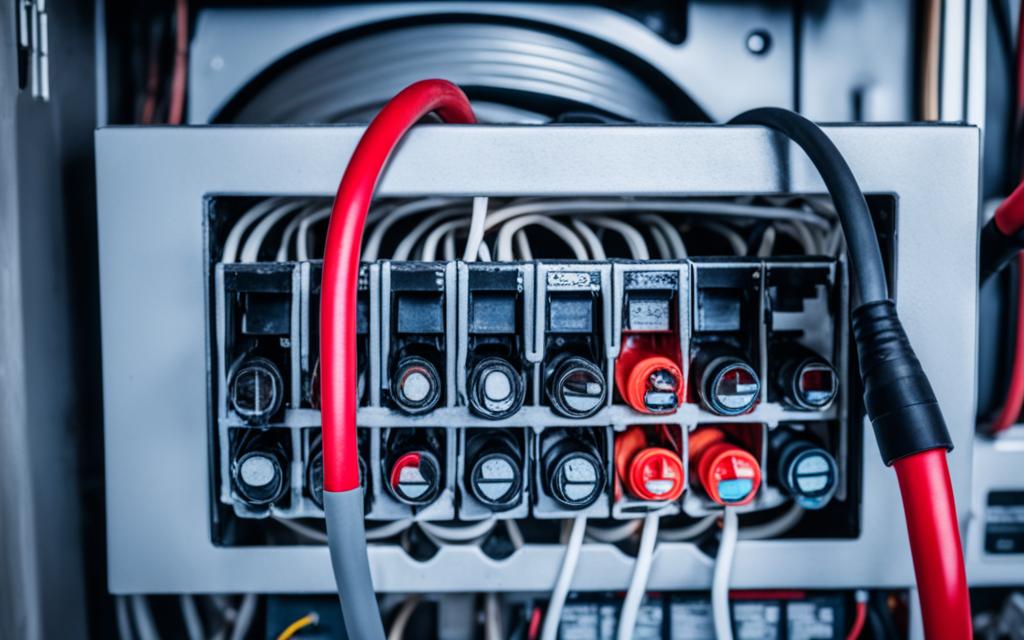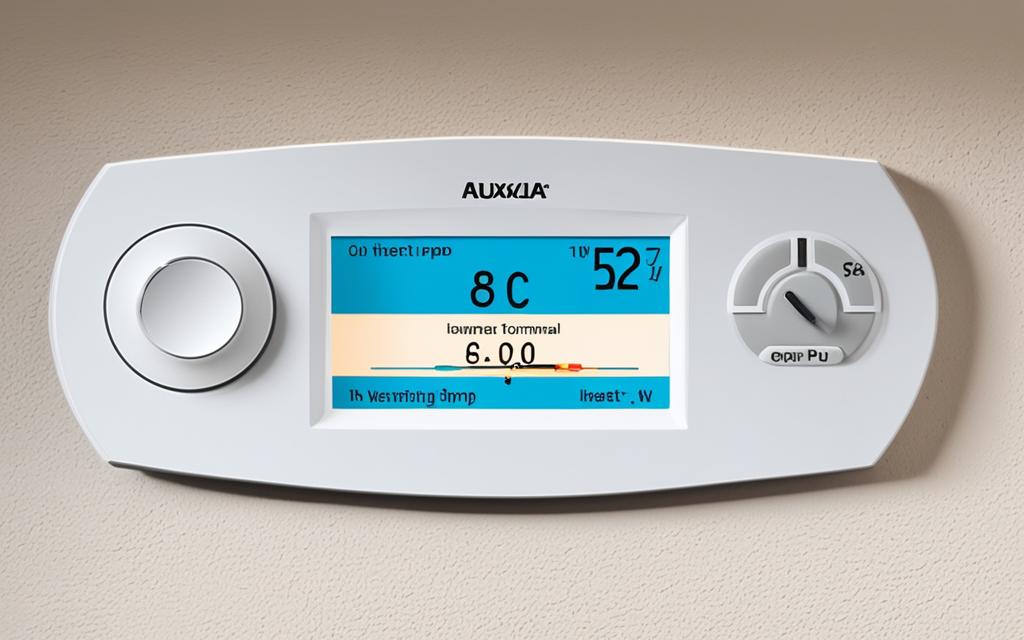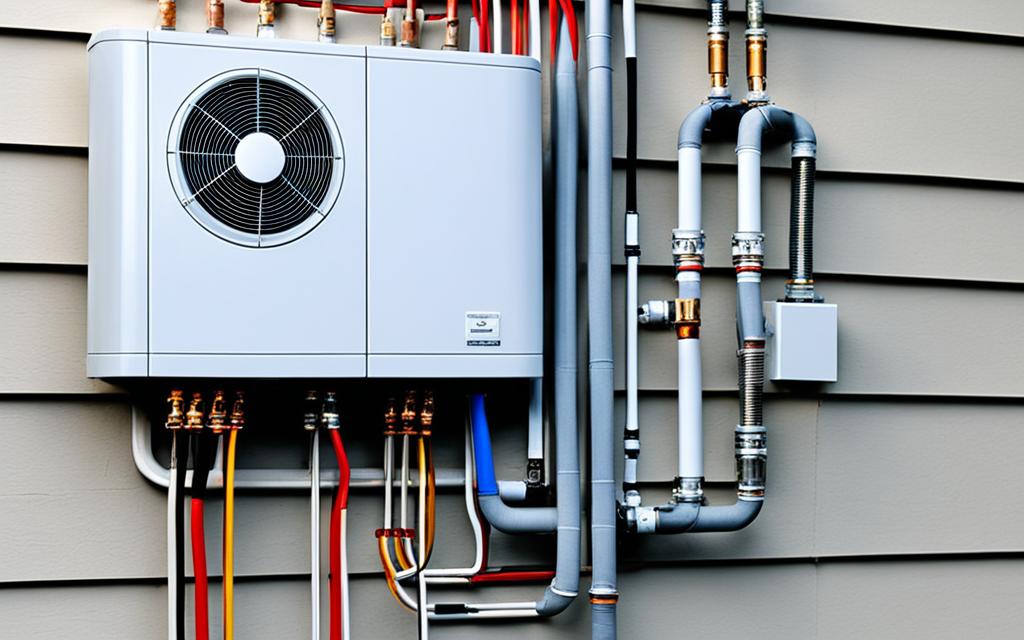Table of Contents
Do i really need a thermostat with aux heat terminal step by step guide below…
If you have a heat pump system in your home, it probably has an auxiliary heat option. You might see auxiliary, aux, or emergency settings on your thermostat. This extra heat helps your heat pump warm your home faster when it can’t do it alone.
There are times when a heat pump can’t warm your space quickly enough. That’s when the auxiliary heat takes over. It gives your home an extra boost to heat up faster.
Auxiliary heat turns on when it gets really cold outside or if you quickly raise your thermostat. This ensures your home stays warm and cozy.
Key Takeaways
- Auxiliary heat is an additional heating system that supplements a heat pump-based system.
- It provides extra heat to warm up a home faster than the heat pump alone.
- Auxiliary heat kicks in when outdoor temperatures drop or the thermostat is raised significantly.
- Understanding the role of auxiliary heat can help optimize your home’s heating and cooling system.
- Choosing a thermostat with an aux heat terminal can provide enhanced control and efficiency.
What is Auxiliary Heat?
In the world of heating technology, auxiliary heat is key in heat pump systems. Heat pumps move heat from one place to another, unlike traditional furnaces that make their own heat. When it gets too cold outside, heat pumps can’t always get enough warmth. That’s when auxiliary heat kicks in.
Understanding the Role of Auxiliary Heat in Heat Pump Systems
Auxiliary heat is an extra heating system that helps a heat pump system. It adds more heat when it’s really cold outside, between 35 and 40 degrees Fahrenheit or colder. This makes sure your home stays warm, even in the coldest winter.
The auxiliary heat system works with the heat pump. It turns on when the heat pump can’t keep the house warm enough. By working together, these HVAC components make sure your home stays warm all year, no matter the weather.
“Auxiliary heat is an essential component of heat pump systems, providing that extra boost of warmth when the outdoor temperatures dip below the heat pump’s comfort zone.”
Knowing about auxiliary heat in heat pump systems is important. It helps keep your home cozy and makes your heating technology work better.
How Does Auxiliary Heat Work?
Understanding how auxiliary heat works is key with heat pump systems. Heat pumps efficiently move heat but may not keep up in very cold weather. That’s when auxiliary heat helps keep your home warm.
The auxiliary heat system is inside the indoor unit of your HVAC. It’s an extra heating source that turns on when the heat pump can’t warm your home enough. This happens when it gets really cold outside and the heat pump works less efficiently.
- The auxiliary heat system is usually powered by electricity, though it can also use gas or oil as an energy source.
- Electric auxiliary heating systems use coils like those in a toaster. These coils quickly warm the air, making the heat pump work better.
- The auxiliary heater doesn’t replace the heat pump. It works with the heat pump to keep your home warm, even in very cold weather.
Knowing how auxiliary heat works and its part in heat pump operation helps homeowners value this HVAC system component. It’s key for a cozy home all year.
“The auxiliary heater is a supplement to the heat pump, not a replacement, and helps the heat pump run more efficiently.”
When is Auxiliary Heat Used?
Auxiliary heat is key to making heat pump systems work well, especially in the cold. It helps keep homes warm and cozy. Knowing when auxiliary heat is used can help homeowners manage their heating better and save energy.
Common Scenarios for Auxiliary Heat Activation
Auxiliary heat is often turned on in the morning when it’s cold. People often lower the thermostat at night to save energy and sleep better. But in the morning, they raise it to get the house warm again. This can be too much for the heat pump alone, especially since mornings are usually the coldest.
At these times, auxiliary heat helps warm the home fast. It makes sure the house is comfortable to live in.
Another time auxiliary heat is used is during long cold spells. When it’s really cold outside, heat pumps work less well. Auxiliary heat adds extra warmth to keep the house at the right temperature. This keeps home heating efficiency high.
Auxiliary heat turns on automatically to keep the home warm and cozy. It works even when heat pump operation in cold weather is tough.
The Difference Between Auxiliary Heat and Emergency Heat
Many homeowners mix up “auxiliary heat” and “emergency heat” when it comes to heat pump systems. It’s important to know the difference to make sure your HVAC system works well.
Auxiliary heat kicks in when it gets cold outside or when you need more heat. It’s like a backup, using electric or gas to help your heat pump. This keeps your home warm when it’s chilly. Auxiliary heat is a key part of how your HVAC system works.
Emergency heat is for real emergencies, like when your outdoor heat pump breaks down. It uses only the indoor unit for heat, skipping the outdoor pump. Use it only when needed, as it’s not as efficient and costs more.
To sum up, auxiliary heat and emergency heat are two different ways your HVAC system heats your home. Knowing the difference helps you use your system better and save energy.https://www.youtube.com/embed/qiAOvJhq8_s
“Proper understanding and use of auxiliary and emergency heat can lead to significant energy savings and improved comfort in your home.”
Is Auxiliary Heat Inefficient?
Heat pump systems use auxiliary heat as a backup, not the main heating source. Heat pumps are efficient and cost-effective. But, auxiliary heat can be less efficient and more costly.
Understanding the Energy Costs of Auxiliary Heat
Heat pumps pull heat from outside air and bring it inside. This makes them a energy-efficient choice for heating. But, when auxiliary heat kicks in, costs can go up a lot. This is because auxiliary heat, usually electric or gas, isn’t as efficient as the main heat pump unit.
In mild weather, the heat pump can handle the heat alone. But in cold weather, it might need extra help from auxiliary heat. This is when your energy costs of heat pump systems will go up.
To keep your system running well and cut down on auxiliary heat use, watch how it performs. If you’re using a lot of auxiliary heat, your system might have a problem. It needs fixing.
“Auxiliary heat is meant to be a supplement to a heat pump system, not a heating system on its own. Heat pump systems are incredibly efficient and affordable for certain mild-climate areas of the country. But when the auxiliary heat is being used, it means lower energy efficiency and higher energy costs.”
Knowing how auxiliary heat works helps you make your heat pump system work better. This way, you can keep your energy costs of heat pump systems low.
Troubleshooting Auxiliary Heat Issues
Having a heat pump system that doesn’t heat your home can be frustrating. But, troubleshooting auxiliary heat issues is often easy. If your auxiliary heat isn’t working, try these simple steps to fix it.
One common reason for this problem is a power issue. First, check your home’s fuse box or circuit breakers. Make sure there are no blown fuses or tripped breakers. This can stop your auxiliary heating system from working.
Next, look at your thermostat. Ensure it’s set to “heat” and the temperature is higher than the room’s current temperature. Also, check that the thermostat talks to the heat pump system correctly and the aux heat settings are right.
- Check the fuse box and circuit breakers for any issues
- Verify the thermostat is set to “heat” mode and the desired temperature is higher than the current temperature
- Ensure the thermostat is properly communicating with the heat pump system
- Check for any power switches near the outdoor heat pump unit
If these steps don’t fix the problem, it’s time to call an HVAC troubleshooting expert. They can do a detailed heat pump system maintenance check. This can find any hidden issues with the HVAC troubleshooting parts.
“Proper maintenance and timely troubleshooting of your heat pump system can help ensure reliable auxiliary heat when you need it most.”

Fixing auxiliary heat problems quickly keeps your home cozy and saves on energy bills. With some troubleshooting, you can make your heat pump system work better. This way, you’ll enjoy efficient and reliable heating all season.
Do I Really Need a Thermostat with Aux Heat Terminal?
If you have a heat pump system, a thermostat with an aux heat terminal is key. The aux heat boosts the system when it’s cold or the heat pump can’t keep up. It’s a vital part of the system.
Skipping a thermostat with an aux heat terminal isn’t wise. The aux heat keeps your home comfy and efficient in the cold. With this feature, your heat pump system works right and keeps your home warm all year.
Heat Pump System Requirements
Heat pumps work well in moderate weather but can struggle in the cold. That’s where the aux heat terminal helps. It lets your thermostat use extra heating sources for warmth in extreme cold.
Without an aux heat terminal, your heat pump might not keep your home at your preferred temperature. This can make your home uncomfortable and increase your energy bills.
HVAC System Components
- Heat pump unit
- Thermostat with aux heat terminal
- Supplemental heating source (electric or gas-powered)
- Refrigerant lines and compressor
- Air ducts and vents
Having a thermostat with an aux heat terminal means your HVAC system can handle different seasons. It keeps your home comfortable all year.
“A thermostat with an aux heat terminal is an essential component for a heat pump system in colder climates. It ensures your home stays warm and cozy even when the temperatures drop.”
| Feature | Benefit |
|---|---|
| Aux heat terminal on thermostat | Activates supplemental heating when needed for increased comfort and efficiency |
| Integrated heat pump system | Provides efficient heating and cooling throughout the year |
| Properly sized HVAC components | Ensures optimal performance and energy usage |
Maintaining Your Heat Pump System
Keeping your heat pump system in good shape is key for your comfort and saving energy. By following simple maintenance tips, you can make sure your heat pump, including the auxiliary heat, works well.
Tips for Efficient Operation and Energy Savings
Regular maintenance helps your heat pump system work efficiently. Here are some tips for better home heating and HVAC operation:
- Change air filters often – Dirty filters make your system work harder and use more energy.
- Keep the outdoor unit clear – Make sure the area around the outdoor heat pump is free of leaves and other debris.
- Get professional tune-ups – A yearly check-up by an HVAC expert can fix small issues before they get worse.
- Use a smart thermostat – These thermostats help control when the auxiliary heat kicks in, saving energy.
By keeping up with heat pump system maintenance and adjusting your thermostat wisely, you can stay comfortable at home while cutting your energy bills. With a bit of effort, your system will run efficiently and save energy.

“Proper maintenance is key to ensuring your heat pump system operates at its best, providing efficient and cost-effective home heating all year round.”
Conclusion
Auxiliary heat is key to a heat pump system, giving an extra boost when it’s cold or the pump can’t keep up. It might not be as efficient as the main heat pump, but it’s needed to keep your home warm in the cold.
Knowing how auxiliary heat works and when to use it is important. It helps your heat pump system work right. By taking care of your system and adjusting your thermostat wisely, you can make your heating both efficient and cost-effective, no matter the weather.
Finding the right balance between the main heating and auxiliary heat is crucial. With this knowledge, you can manage your heat pump system well. This ensures you stay comfortable and save on energy all year round.
FAQ
Do I really need a thermostat with aux heat terminal?
Yes, if your home has a heat pump, it probably has an auxiliary heat function. A thermostat with an aux heat terminal is crucial. It makes sure your heat pump works right and gives extra heating when needed.
What is Auxiliary Heat?
Auxiliary (aux) heat is an extra heating system that helps a heat pump warm your home faster. It’s key for keeping your home comfy and efficient in cold weather.
How Does Auxiliary Heat Work?
The indoor unit of a heat pump system has the auxiliary heat system. It turns on automatically when it gets cold outside. This system uses electricity to heat the air quickly, similar to a toaster.
When is Auxiliary Heat Used?
Auxiliary heat turns on when it’s too cold outside or if you quickly raise your thermostat. This often happens in the morning, when you need to warm up your home after turning down the heat at night.
What’s the Difference Between Auxiliary Heat and Emergency Heat?
Auxiliary heat is part of your heating system and turns on when needed. Emergency heat, however, must be manually turned on. Use it only if your outdoor heat pump unit isn’t working.
Is Auxiliary Heat Inefficient?
Auxiliary heat uses more energy than the outdoor heat pump unit. So, try to use it less. In warmer temperatures, the heat pump can warm your home more efficiently.
How Can I Troubleshoot Auxiliary Heat Issues?
If aux heat isn’t working, check for blown fuses or tripped circuit breakers. Make sure your thermostat is set right and look for a power switch near the heat pump. If problems continue, call an HVAC expert.
Share this content:
